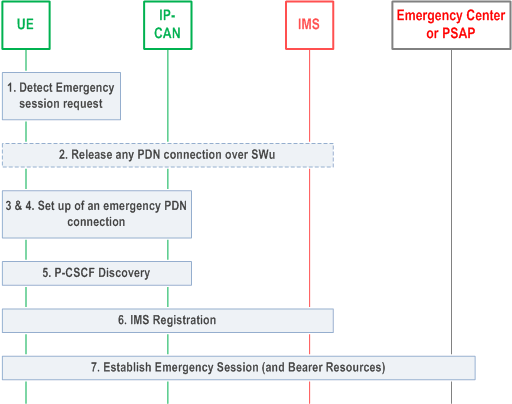Content for TS 23.167 Word version: 19.0.0
I IMS Emergency Services Using HRPD/EPC Network
I.1 cdma2000 HRPD/EPC Options
I.2 Requirements on the HRPD/EPC Network as an IP-CAN
I.3 Information Flows
J IMS emergency services using WLAN access to EPC
J.1 General
J.2 UE specific behaviour
J.3 High Level Procedures for IMS emergency calls
J.4 Location handling
...
...
I (Normative) IMS Emergency Services Using HRPD/EPC Network |R9| p. 57
I.1 cdma2000 HRPD/EPC Options p. 57
The following options from the normative clauses of this TS are applicable in cdma2000 HRPD systems with an EPC core network:
- Clause 7.1.1, step 4 "The IP-CAN may support a UE indication that this request is for an emergency service".
- Clause 4.1 "The P-CSCF serving the emergency call is the IMS network entity which may retrieve the location identifier from the IP-CAN".
I.2 Requirements on the HRPD/EPC Network as an IP-CAN p. 57
For an emergency call over HRPD/EPC, the requirements on the IP CAN are specified in 3GPP2 X.S0057-A [39].
I.3 Information Flows p. 57
The informational flows for emergency calls over HRPD are provided in 3GPP2 X.S0057-A [39].
J (Normative) IMS emergency services using WLAN access to EPC |R13| p. 58
J.1 General p. 58
This Annex includes additional clarifications when the IP-CAN corresponds to a WLAN access to EPC.
Both trusted WLAN access (S2a) and Untrusted WLAN access (S2b) to EPC for emergency sessions are supported.
The UE may issue an Emergency session over WLAN access to EPC only when 3GPP access for emergency call is not possible or available (e.g. no 3GPP coverage).
Further details on the procedures defined for WLAN access to EPC support of support emergency sessions are defined in TS 23.402.
J.2 UE specific behaviour p. 58
Procedure for determining the list of emergency numbers:
- In addition to the emergency numbers and associated types stored either on the USIM or on the user equipment specified in clause 10.1.1 of TS 22.101, the UE shall use the stored Local Emergency Numbers List received from the 3GPP network to detect that the number dialled is an emergency number.
- If a UE has a SIM/USIM and has received a list of emergency numbers and associated types via mobility management procedures as described in TS 24.301 or TS 24.008 when connected to the PLMN using GERAN, UTRAN, E-UTRAN or TS 24.501 when connected to NG-RAN or non-3GPP access connected to 5GC, or, for a UE supporting access to 5GC using non-3GPP access, as specified in Annex L, the UE shall use this list to determine if the dialled digits correspond to an emergency call as long as the UE has determined that the list is valid (see clause 4.1).
-
The UE may also determine that the dialled digits and associated types or URN information correspond to an emergency call based on the list of emergency numbers retrieved by one of the following means:
- via Access Network Query Protocol (ANQP) procedures defined in IEEE Std 802.11-2012 [47] from the associated WLAN AP upon completing authentication with the trusted WLAN access to EPC, with management frame protection enabled.
- via a previous query to a DNS only when that DNS is in the same country as the UE and is an internal DNS server in the 3GPP network whose address is acquired from the ePDG; or
- via IKEv2 procedures from ePDG.
- The list of downloaded emergency numbers shall be deleted at country change or, if the particular list is only valid for a PLMN, see clause 10.4.1 of TS 22.101), at successful registration with a different PLMN.
- The UE shall establish an emergency PDN connection over WLAN and shall perform an IMS emergency registration before sending an IMS emergency session request.
- The UE shall include any available location information in the IMS emergency session request. This is further detailed in TS 23.228.
- For the media supported during IMS emergency sessions, media codec and format support is specified in TS 26.114.
- For the support of DRVCC on emergency call on WLAN, see TS 23.237.
J.3 High Level Procedures for IMS emergency calls p. 59
For the high level procedures (as described in clause 7.1.1) the following statements apply for UE detected emergency calls when EPC access over WLAN is used:
- the IP-CAN bearer resource is a PDN connection dedicated for emergency services. The TS 23.402 describes how to indicate that a PDN connection request is for emergency;
- For registration requests received from an emergency PDN connection, the P-CSCF shall reject any IMS registration which is not for the emergency purpose.
- The P-CSCF may reject the session initiation request with an indication that this is an emergency session or may allow the session initiation request to continue.

The following steps are performed:
Step 1.
Same as step 1 of Figure 7.1.
Step 2.
The UE releases any PDN connection it may have over untrusted access to EPC.
Step 3.
Void.
Step 4.
As described in TS 23.402:
Step 5.
- in the case of untrusted access, the UE selects an ePDG for emergency services and sets-up a PDN connection for emergency services;
- in the case of trusted access, the UE sets-up a PDN connection for emergency services. The UE is assigned an IP address at this stage.
Same as step 5 of Figure 7.1.
Step 6.
Same as step 6 of Figure 7.1.
Step 7.
Same as step 7 of Figure 7.1.
J.4 Location handling p. 60
When a UE performs an emergency registration or initiates an emergency session over WLAN access to EPC the UE provides location information that is further defined in TS 23.228.
If the operator policy requires network provided location using PCC-based solutions for the UE location, the P-CSCF may retrieve location information from the access network as defined in TS 23.203 and includes it in the emergency session request, as described in TS 23.228.